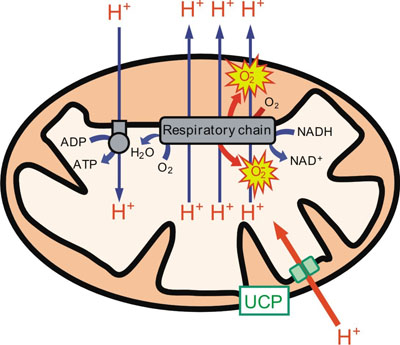Mitochondrial bioenergetics
The mitochondrial oxidative phosphorylation embraces the reactions that allow ATP synthesis using the energy made available from substrate oxidation at the respiratory chain. The two processes are coupled through the proton gradient generated during the transfer of electrons from the substrates to oxygen. Our group investigates the mechanisms that modulate the energetic efficiency of the process.
The uncoupling proteins (abbreviated UCP) are carriers of the mitochondrial inner membrane whose biological function is to allow a regulated discharge of the proton gradient. There are a large number of processes that appear to involve the UCPs.

For example, this energy dissipatory mechanism is used by mammals to maintain body temperature when cold exposed or to burn excess calories ingested with the diet. Since the UCPs catalyze the re-entry of protons into the mitochondrial matrix, they cause an increase in the rate of respiration that leads to a decrease in the production of reactive oxygen species (ROS) and therefore the UCPs are an element of the cellular defences again oxidative stress. Thus, the uncoupling protein UCP2, which is found in many tissues and organs, is over-expressed in pathological processes in which ROS play an important role in the development of the disease (atherosclerosis, cancer, chronic inflammation, etc.).
Recent publications
- A novel regulatory mechanism for the brown-fat uncoupling protein?. Nat Struct Mol Biol. 2016;23(5):364-5
- Zebrafish Models for Human Acute Organophosphorus Poisoning Sci Rep. 2015;5:15591
- NAMPK and PFKFB3 mediate glycolysis and survival in response to mitophagy during mitotic arrest. Nat Cell Biol, 2015, 17, 1304-13
- Reshaping of Human Macrophage Polarization through Modulation of Glucose Catabolic Pathways. J Inmunol, 2015, 195, 2442-2451
- Differences in ATP Generation Via Glycolysis and Oxidative Phosphorylation and Relationships with Sperm Motility in Mouse Species. J Biol Chem 2015, 290, 20613-20126
- Leishmania infantum modulates host macrophage mitochondrial metabolism by hijacking the SIRT1-AMPK axis. PLoS Pathog, 2015,11, e1004684
- Apoptotic efficacy of etomoxir in human acute myeloid leukemia cells. Cooperation with arsenic trioxide and glycolytic inhibitors, and regulation by oxidative stress and protein kinase activitiesPLoS One. 2014; 9(12):e115250.
- Laminar shear stress regulates mitochondrial dynamics, bioenergetics responses and PRX3 activation in endothelial cells. Biocjim Biophys Acta 2014, 1843, 2403-2413
- Regulation of death induction and chemosensitizing action of 3-bromopyruvate in myeloid leukemia cells: energy depletion, oxidative stress, and protein kinase activity modulation.J Pharmacol Exp Ther, 2014, 348, 324-325
- Glucagon regulation of oxidative phosphorylation requires an increase in matrix adenine nucleotide content through Ca2+ activation of the mitochondrial ATP-Mg/Pi carrier SCaMC-3. J Biol Chem. 2013;288(11):7791
 Address This email address is being protected from spambots. You need JavaScript enabled to view it. 91 8373112. Centro de Investigaciones Biológicas Ramiro de Maeztu,9 28040 Madrid
Address This email address is being protected from spambots. You need JavaScript enabled to view it. 91 8373112. Centro de Investigaciones Biológicas Ramiro de Maeztu,9 28040 Madrid 